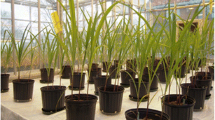Abstract
A low-cost, low-maintenance system for soilless production of vesicular-arbuscular mycorrhizal (VAM) fungus spores and inoculum was developed and adapted for production of acidophilic and basophilic isolates. Corn (Zea mays) plants were grown with Glomus etunicatum, G. mosseae or Gigaspora margarita in sand automatically irrigated with modified Hoagland's solution. Sand particle size, irrigation frequency, P concentration, and buffer constituents were adjusted to maximize spore production. Modified half-strength Hoagland's solution buffered with 4-morpholine ethane-sulfonic acid (MES) automatically applied 5 times/day resulted in production of 235 G. etunicatum spores/g dry wt. of medium (341000 spores/pot) and 44 G. margarita spores/g dry wt. of medium (64800 spores/pot). For six basophilic isolates of G. mosseae, CaCO3 was incorporated into the sand and pots were supplied with the same nutrient solution as for acidophilic isolates. The increased pH from 6.1±0.2 to 7.2±0.2 resulted in spore production ranging from 70 to 145 spores/g dry wt. (102000–210000 spores/pot). Spore production by all isolates grown in the soilless sand system at Beltsville has exceeded that of traditional soil mixtures by 32–362% in 8–12 weeks.
Similar content being viewed by others
References
Asher CJ, Edwards DG (1983) Modern solution culture techniques. In: Läuchli A, Bielski RL (eds) Inorganic plant nutrition. (Encyclopedia of plant physiology, new series, vol 15) Springer, Berlin Heidelberg New York, pp 94–119
Becard G, Piche Y (1989) Fungal growth stimulation by CO2 and root exudates in vesicular-arbuscular mycorrhizal symbiosis. Appl Environ Microbiol 55:2320–2325
Ferguson JJ, Woodhead SH (1982) Production of endomycorrhizal inoculum. A. Increase and maintenance of vesicular-arbuscular mycorrhizal fungi. In: Schenck NC (ed) Methods and principles of mycorrhizal research. American Phytopathological Society, St Paul, Minn, pp 47–54
Franke M, Morton JB (1990) Phylogenetic relationships among two Scutellispora species based on comparative ontogeny (abstract). Eighth North American Conference on Mycorrhizae, Jackson Hole, Wyo. San Diego State University, Systems Ecology Research, San Diego, Calif, p 104
Hepper CM, Sen R, Azcon-A C, Grace C (1988) Variation in certain isozymes amongst different geographical isolates of the vesicular-arbuscular mycorrhizal fungi Glomus clarum, Glomus monosporum and Glomus mosseae. Soil Biol Biochem 20:51–59
Howeler RH, Asher CJ, Edwards DG (1982) Establishment of an effective endomycorrhizal association on cassava in flowing solution culture and its effects on phosphorus nutrition. New Phytol 90:229–238
Millner PD, Meyer RJ (1990) Analysis of amplified ribosomal DNA fragments from VAM fungi (abstract). Eighth North American Conference on Mycorrhizae. Jackson, Wyo. San Diego State University, Systems Ecology Research, San Diego, Calif, p 210
Morton JB, Benny GL (1990) Revised classification of arbuscular mycorrhizal fungi (Zygomycetes): a new order, Glomales, two new suborders, Glomineae and Gigasporineae, and two new families, Acaulosporaceae and Gigasporaceae, with an emendation of Glomaceae. Mycotaxon 37:471–491
Mosse B, Thompson JP (1984) Vesicular-arbuscular endomycorrhizal inoculum production. I. Exploratory experiments with beans (Phaseolus vulgaris) in nutrient flow culture. Can J Bot 62:1523–1530
Mugnier J, Mosse B (1987) Vesicular-arbuscular mycorrhizal infection in transformed root-inducing T-DNA roots grown axenically. Phytopathology 77:1045–1050
Ojala JC, Jarrell WM (1980) Hydroponic sand culture system for mycorrhizal research. Plant Soil 57:297–303
Parvathi K, Venkateswarul K, Rao AS (1984) Development of the VAM fungus. Glomus mosseae in groundnut in static solution culture. Proc Indian Acad Sci (Plant Sci) 93:105–110
SAS (1985) SAS/STAT guide for personal computers, version 6 edn. SAS Institute, Cary, NC
Sylvia DM (1988) Activity of external hyphae of vesicular-arbuscular mycorrhizal fungi. Soil Biol Biochem 20:39–43
Sylvia DM, Hubbell DH (1986) Growth and sporulation of vesicular-arbuscular mycorrhizal fungi in aeroponic and membrane systems. Symbiosis 1:259–267
Wright SF, Morton JB, Sworobuk JE (1987) Identification of a vesicular-arbuscular mycorrhizal fungus by using monoclonal antibodies in an enzyme-linked immunosorbent assay. Appl Environ Microbiol 53:2222–2225
Author information
Authors and Affiliations
Rights and permissions
About this article
Cite this article
Millner, P.D., Kitt, D.G. The Beltsville method for soilless production of vesicular-arbuscular mycorrhizal fungi. Mycorrhiza 2, 9–15 (1992). https://doi.org/10.1007/BF00206278
Issue Date:
DOI: https://doi.org/10.1007/BF00206278




